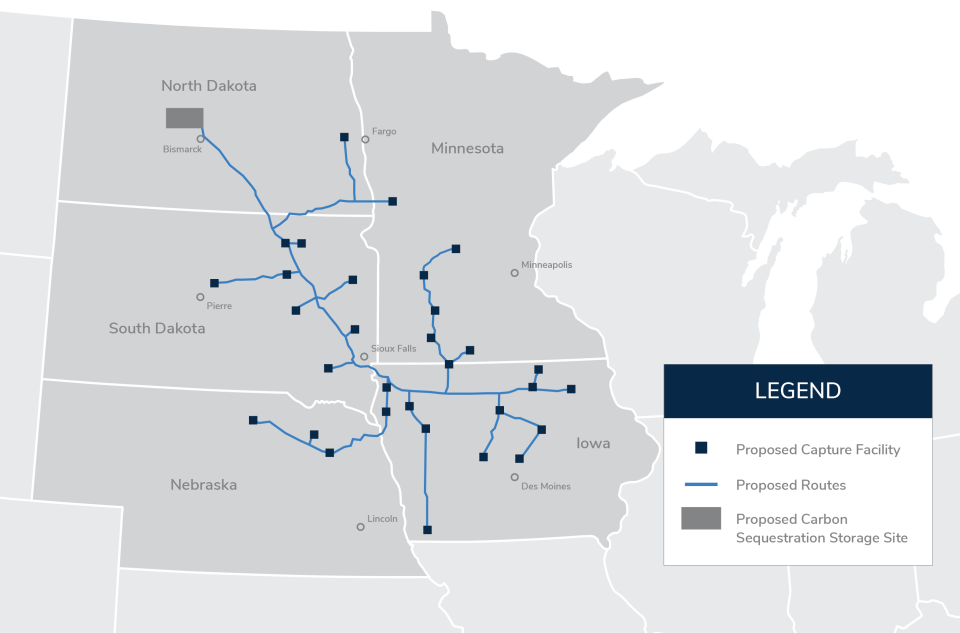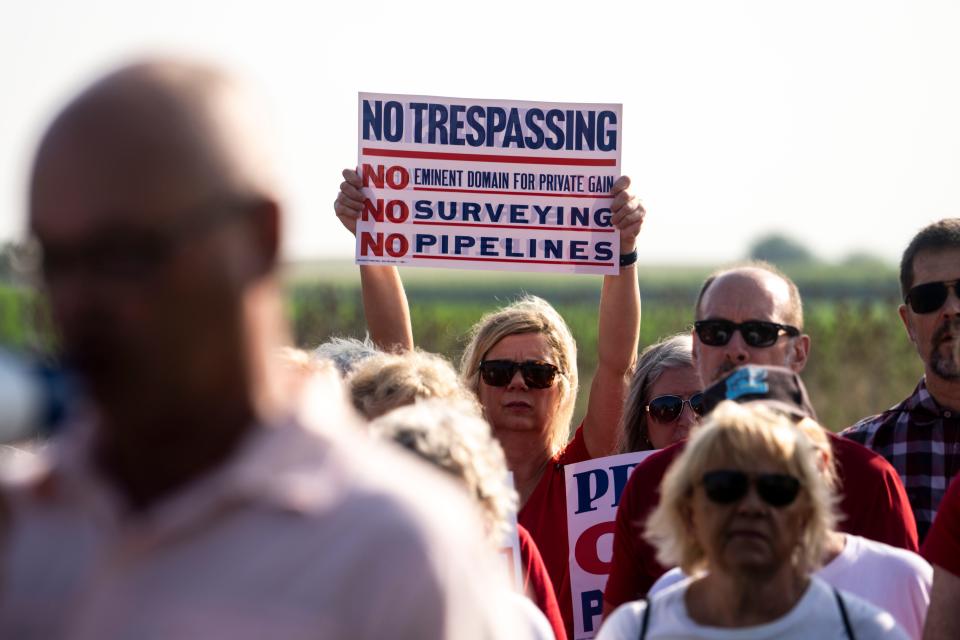Q&A: Summit Carbon Solutions execs say ethanol’s future hangs in the balance

MARION — If South Dakota’s ethanol industry does not reduce the amount of heat-trapping carbon dioxide it emits into the atmosphere, the industry’s future is grim.
That’s according to two top executives of the remaining carbon-capture pipeline company hoping to capture, liquefy and bury carbon dioxide from South Dakota ethanol plants. They said markets around the globe are demanding lower carbon emissions.
“Electric vehicles are continuing to grow,” said Summit Carbon Solutions CEO Lee Blank. “They are, and maybe not here, but in cities. Our gas consumption is going down. So how do we open up other markets so ethanol consumption goes up?”
One of those other markets, according to Summit, could be sustainable aviation fuel from a plant proposed in Lake Preston by a company called Gevo.
Summit’s pipeline would cross land owned by state Rep. Karla Lems, R-Canton. She said a carbon-capture pipeline isn’t the only way to lower emissions from corn-based ethanol.
“What would it mean if ethanol plants only purchased corn from farmers doing sustainable practices,” Lems asked, “like no-till and cover crops, which pull carbon into the ground?”
In September, state regulators denied permits for Summit and another company seeking to build carbon pipelines in the state.
The other company, Navigator C02, has since withdrawn its plan. Iowa-based Summit plans to resubmit an application after modifying its route.
The company aims to capture carbon dioxide emitted from 32 Midwest ethanol plants and transport it in liquefied form for underground storage in North Dakota, thereby making the project eligible for federal tax credits that incentivize the removal of greenhouse gasses from the atmosphere.
Summit’s multi-billion-dollar project is led by Blank and Chief Operating Officer Jimmy Powell. Blank is an experienced agriculture industry executive, while Powell’s background is in energy, pipelines and oil.
On Wednesday, the two sat down with South Dakota Searchlight at NuGen in Marion, which is one of Summit’s partner ethanol plants.
The following are excerpts — edited for length — from that interview.

Why is your pipeline project important to ethanol plants?
Blank: The reason it’s important to the ethanol industry is it lowers the carbon intensity on their products. And there are markets today nationally and globally that want a lower carbon-intensity fuel, and they’ll pay a premium for that.
And so by lowering that carbon intensity on the ethanol that they’re producing, they can sell that ethanol into premium markets and deliver a premium back to the ethanol plant.
Powell: To sell in these markets, and to sell to the sustainable aviation markets, which are evolving, you have to have a carbon intensity score of less than 50.
This plant [NuGen in Marion] is one of the newer plants, and it’s in that ballpark. A lot of the plants that we partner with have a score in the 60s and 70s.
If they power this entire plant with a solar farm or wind turbines, it’s going to give them a three- or five-point reduction. Meanwhile, by pulling the CO2 stream out of their process, it cuts it 25 to 30 points.
So they can’t get the same bang for their buck doing anything but pulling the CO2 out.
Right now, it’s about a 50-cent margin in those low-carbon fuel markets. So, if it’s 15 cents to transport to those markets, they net 35 cents a gallon.

What is Summit Carbon Solutions’ business model?
Blank: We partner with the plants. So it’s a shared revenue model with the plants.
We’re putting up all the capital for all the capture equipment, all the infrastructure, all the sequestration. We don’t ask the plant to put up anything. And then, through the premiums — what we call “uplift,” which is what Jimmy was just talking about, that 35 cents a gallon uplift — we share the operating costs and return on our capital back out of that, and then everything else is shared with the plant.
So the plants don’t make any investment. But after we get a return on investment, everything from there is a shared model going forward.
So that’s how we earn revenues off of this particular model through a shared partnership with the ethanol industry.
Who will receive the federal tax credits?
Blank: The tax credit is just one of the revenue streams that gets split in the revenue model as it comes in.
Once we put that ton of carbon in the ground, that generates the tax credit for that ton that’s been sequestered.
And then, that tax credit comes back to the business and it’s shared. After we take the operating expenses out of the company, just like everything else, that revenue from that tax credit is a shared model.
Sustainable aviation fuel is one of the future markets discussed that could make up for the loss in ethanol demand as electric vehicles grow in popularity. How does Summit fit into that?
Blank: The U.S. ethanol industry is supplying about 15 billion gallons into U.S. gasoline markets.
There are 100 billion gallons, globally, of aviation fuel. They all have sustainable goals that they want to try to meet by 2030, 2040, 2050.
They’re saying that without low carbon-intensity ethanol, there is no way the airline industry will meet its sustainability goals. And that’s because, basically, without the carbon pipeline, you can’t get the carbon intensity score low enough on the ethanol to qualify for the sustainable aviation fuel markets.
And so, it’s important that we get it done, because it opens up the ethanol industry to another market. It’s not 100 billion gallons, because it’s a blend, but it’s an additional 50 billion gallons.
Think about that: The gasoline markets are only supplying 15 billion gallons today.
We can open this up for agriculture to another 50 billion gallons of ethanol. Imagine what that can do for the U.S. corn farmer and what it means to the value of his farming operation going forward.
Are you saying sustainable aviation fuel would be 50% ethanol?
Blank: No, it’s a ratio.
So, remember, the first thing that has to happen is we have to lower the carbon intensity score of the ethanol. Then it has to go through a process through a sustainable aviation fuel plant that has to work to get it to a position where it’s what they call a drop-in fuel.
And I’m not an engineer, so I’m not going to tell you exactly how that works, but that drop-in fuel then becomes a fuel that will fly.
As a matter of fact, yesterday, Virgin flew their first 100% sustainable Aviation fuel flight across the Atlantic Ocean with all drop-in sustainable aviation fuel.
Now, they can blend it, and they probably will blend it going forward. But it’s a big blend. So you open up the ethanol markets to a massive market.
Powell: The goal of the major airlines, like Delta, United and Southwest, their goal is 3 billion gallons of sustainable aviation fuel by 2030. They’re targets, but they are pushing for that today.
In this country today, there are less than 100 million gallons produced. So, plants have to be built and they have to be operational.
I’m sure you know about Gevo in this state being one. And if we don’t have this project, if it’s not successful in South Dakota, Gevo will not construct here.
So, the 15 or so ethanol plants in this state will be disadvantaged from that aspect. They won’t be able to access that.
To be clear, what percentage of sustainable aviation fuel would be ethanol?
Powell: Well, think about it like this: It’s like the gasoline at Casey’s. You can get 10% ethanol all the way to E85.
And so, it depends on what the airlines require. Is it 15% blend, 50% blend?
But globally, the way I think about it, the way it’s been presented to us is that the mass demand in the market is about 50% of the total demand.
So, if there’s 100 billion gallons of aviation fuel demand in the market, half of that would be available to sustainable aviation fuel.
Your project’s ability to access land from unwilling landowners via eminent domain stems from its status as a common carrier pipeline — a type of pipeline required by law to offer its services to the public on a non-discriminatory basis. Who else do you anticipate will be asking you to carry their carbon dioxide?
Blank: There are lots of opportunities for that. There are fertilizer plants looking for transport and storage, and others.
But with the failure of Navigator, you know, there’s now another piece of the ethanol industry that would like to think about coming on our pipe now that Navigator’s no longer happening. Those are common carrier-type discussions. When the 45Q tax credit went from $50 a ton to $85 a ton, everything really became available.
And many people don’t want the partnership like we have with this plant. Many just want us to ship it and sequester it for them, and that’s more of the common carrier-type model, and that’s all coming at us now.
Powell: One way to think about it is we’re designing the system for 18 million tons. We don’t have 18 million tons in our contracts.
So we’ll do an open season, like any other pipeline would. And so if you can get your product to the pipeline, and get your product off the pipeline, and it meets our quality spec, we’ll transport it.
Does that mean you’re unable to say no to a customer looking to use liquid carbon for oil-well extraction, by injecting it underground to make the oil flow better?
Powell: We can [say no], because we can’t get it off the pipeline. We’re sequestering it 80 or 90 miles southeast of the oil and gas production areas in North Dakota. So we don’t have a way to get it there.
Now, if a company wanted to build a pipeline and take it from us, and move it up there, that’s something we would have to entertain.
But right now we’re partnered with ethanol. They want to sequester it because it benefits them to do that. And that’s our business model.
This article originally appeared on Sioux Falls Argus Leader: Summit Carbon Solutions execs say ethanol’s future hangs in the balance

